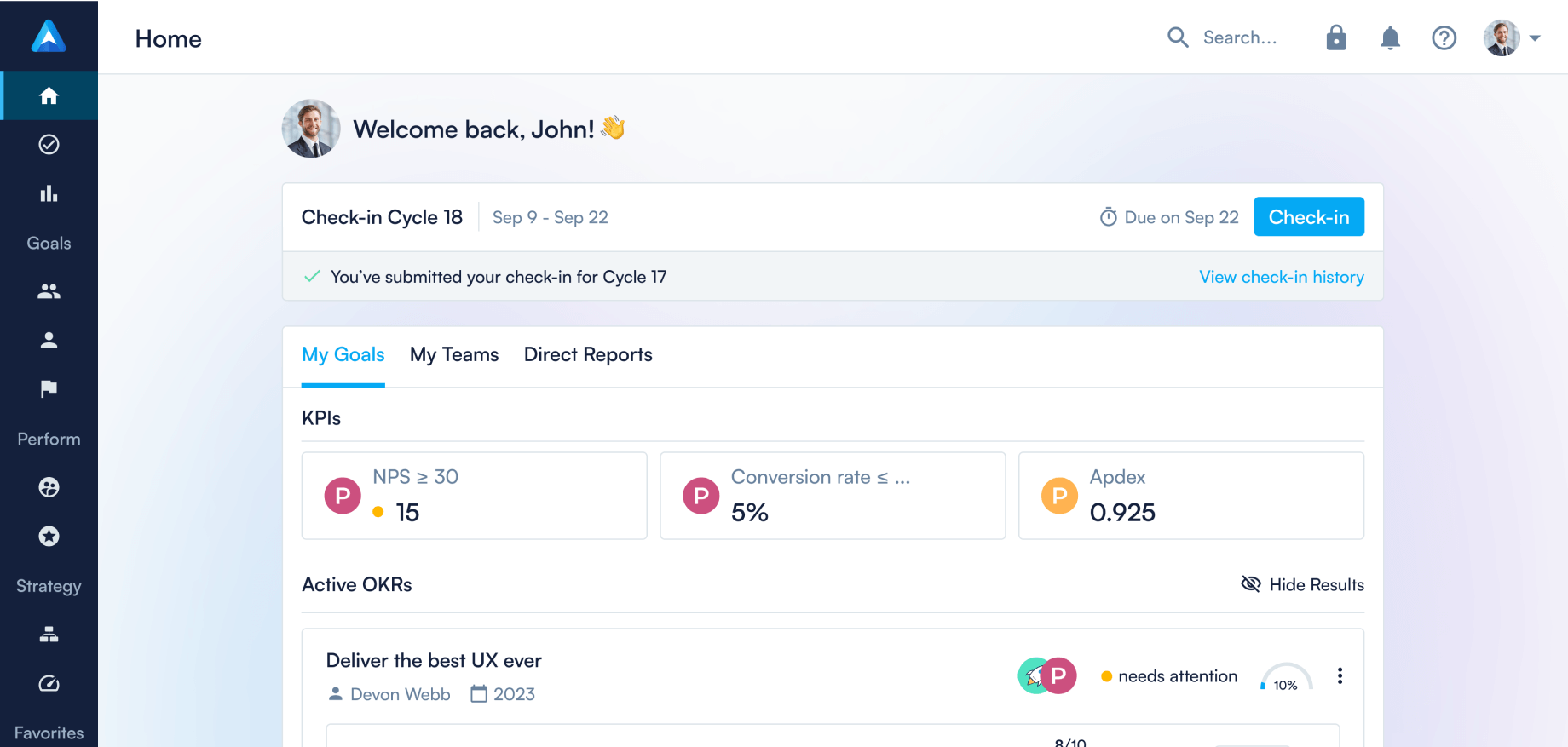
How to keep your business on track with OKRs

OKRs are great for Google, but what good are they gonna do for my company and its business goals, working on launching a breakthrough new product?
We often hear this concern voiced by founders and CEOs. The main concern they have to grapple with is how to develop and stick to a set of Objectives and Key Results when the business goals of their organizations are changing frequently.
OKR is a framework equally useful to small teams and large corporations; to those who need to move fast and change gears as new data becomes available and to those who just need to keep the ship on its steady course. OKR is extremely flexible and it gives teams the freedom to choose the best rhythm depending on the context they operate in.
In the following sections we explore how teams should set up their OKR frameworks to account for cases in which they are aiming at a moving target.
The misconception around OKRs
The most popular concern we hear about OKRs is that they work well for large companies with an established product/business model, but are hard to apply in an organization looking to find market-fit for a new product.
Google is often cited as a successful use case of OKRs, even though it's not the first company to use the framework. However, even within Google, OKRs are more stable over time for some teams than others. For example, Search is an established product, used by millions of people each day. Setting lasting OKRs is easier in this case because you're just looking to improve the product and get more people to use it. On the other hand, when you're working on a new product or on a moonshot project where there's larger variability and direction changes rapidly, OKRs are more likely to change along the way.
However, data from the field shows that even in established teams, 20-25% of OKRs change in progress. The framework is robust enough to allow for a high degree of adaptability and it can even help teams that work in the most uncertain environments.
If you're finding yourself constantly giving up on your established objectives, it might be the sign of a different—maybe even bigger—problem. According to Flurry's Kenton Kivestu, if this is a commonly occurring practice for your team, you fall under one of the following:
- Your team is constantly coming up with boundary-pushing products and features that happen as a result of unplanned discovery.
- You struggle with writing OKRs, resulting in goals that are “not worth doing,” either because they aren't ambitious enough, or because they don't make sense for your company.
- Your team needs to improve discipline and get focussed on the meaningful work you need to do.
Kivestu argues that in the absence of lucky discoveries, OKRs help keep teams on track to make meaningful progress. In a startup environment, where there are hundreds of potential ideas that can be explored, setting OKRs will compel you to think about the truly important business goals and give your team a north star to focus on, even in the face of a rapidly changing environment.
The critical piece you need to make OKRs work is to set the proper cadence for them.
How the cadence works
OKRs don't need to be set in stone. Reviewing and adjusting your business is a natural part of the process of using the OKR framework. Moreover, the best way to apply it is by setting multiple cadences customized around the context of your team.
The framework is meant to provide flexibility for any organization, regardless of size and the maturity of the products they're working on. The main goal of OKRs is to create a link between the overall strategic business goals and the day-to-day tactical actions that allow these goals to become a reality.
In a recent interview, Felipe Castro, an experienced consultant on goal planning and setting, argues that the companies that are best at using OKRs understand that different business goals have different rhythms, so it makes sense to have more than one cadence. In his experience, Felipe's seen that OKRs work best when they decouple strategy from tactics and allow teams to control each. This is usually achieved by using a triple cadence:
- A strategic OKR cadence that sets the general direction for the company. The purpose of this element is to set the long-term vision for the organization. Teams should revisit it occasionally and adjust as priorities and the environment change.
- A tactical cadence that outlines the short-term goals and tasks for each team. Teams within the same organization might even have different cadences based on their context, but managers should look to maximize “synchronization opportunities” to make sure all teams are still working towards a shared goal.
- In addition: a scheduled review cadence, which allows you to revisit both the strategic and tactical OKRs, review progress, and adjust your objectives and tasks, if necessary.
The right framework for each of these elements is up to the internal organization of your team—you could be using monthly, 6-week, or quarterly cadence for your tactical OKRs, an annual or 6-month for your strategic framework, and so on. Spotify is a popular example of a company using a strategic cadence of 6 months and a tactical cadence of 6 weeks.
To succeed with OKRs, you should start by finding the right rhythm for your team.
How to find the best OKR cadence for your team
Using multiple cadences to set long and short-term business goals and review progress systematically allows you to strike the fine balance that makes OKRs such a powerful tool.
Finding that equilibrium is the main struggle of managers getting started with the Objectives and Key Results framework:
- Setting long-term OKRs involves a large degree of uncertainty. Longer cadences work well for established products and companies, where there are few unknowns about the product and the market environment.
- Working with shorter OKR cycles is easier, but goal setting has some inherent degree of overhead, so you should invest in streamlining the process of writing OKRs if you don't want to get bogged down by it.
The best way to conquer this dilemma is by adopting a multi-cadence approach, as discussed in the previous section. Felipe recommends the following approach:
- Annual company-wide OKR framework set by top management that aligns the whole team towards achieving strategic business goals. This is the basis that gives direction to the organization and ensures that every team and individual is working towards something that has practical benefit, even in the face of frequent change.
- Quarterly team/departmental OKRs that set the tactical cadence. These chart the map for achieving the annual objectives of the organization. Getting individual team members involved in setting the quarterly OKRs ensures that they're both aligned and invested in fulfilling the larger goals.
- A mid-quarter review to track progress and make changes as necessary. This is a valuable opportunity to look beyond progress on short-term business goals and decide whether the annual OKRs are still valid and if any of them need to be adjusted.
This is a sound approach for any organization, which is just starting with OKRs. It delivers the best of the framework, while still keeping the overhead associated with setting and managing OKRs in check.
The right OKR cadence boosts success on business goals
Finding the right set of cadences is a matter of balancing between planning too far ahead and spending too much time writing OKRs.
Our experience shows that teams that utilize very short cadences—monthly, for example—tend to use OKRs as very high-level to do lists. This is a very unproductive way to use OKRs, because it focusses on completing tasks rather than creating value for customers and the company. To ensure all Key Results are value-based and measure actual results, Perdoo lets users add “Initiatives” to an OKR, drawing a clear line between things you do (Initiatives) and results that indicate success (Key Results). Initiatives are projects that are intended to drive progress toward achieving the Objective.
On the other hand, planning too far into the future, makes it hard for teams to get aligned towards achieving concrete business goals. This approach also results in highly-volatile OKRs as progress and changes in the environment push you to adjust.
However, spending the time to find the best cadence and write great OKRs can help your team overcome even the most challenging situations by helping you focus on doing the things that are important.
FAQ
Continue reading...


Why you shouldn’t outsource OKR to HR


How to embed goals in performance reviews






